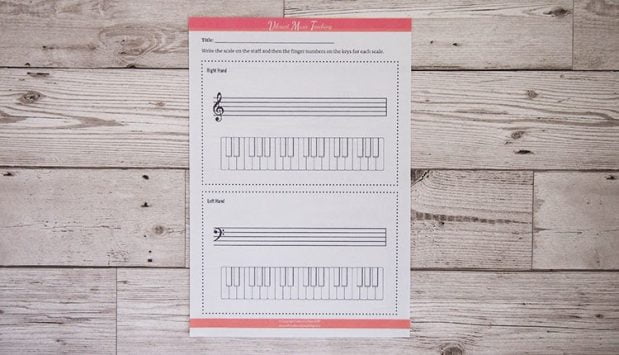When it comes to teaching piano scales, which method do you prefer: notation, writing or pure memory?
Ultimately, I don’t think there’s one best method. In this post and podcast episode, we’ll explore the options so you can try different approaches with your students.

⬆️ Listen to the podcast above or keep on reading, whichever fits your style. ↙️
The approach you use to teach scales to one piano student will not work well for every student. As teachers, we need a variety of tools in our belt.
Let’s explore the three most common ways to teach piano scales so we have lots of options open to us.
#1: Teaching Piano Scales by Rote
Rote teaching is the primary way I teach piano scales, so we’ll start there. Learning by rote has many benefits including pattern recognition, ear training and memorisation.
I think teaching scales by rote also provides more opportunity to explore technique, theory and creative playing since we’re not focussed on reading notation at the same time.
Teaching Scales by Rote with Piano Key Shapes
When teaching by rote, try exploring the scale shapes with your students.

For example: C pentascale and G pentascales are a straight line, D Major and A Major pentascales are the shape of a mountain and E major has two black keys followed by two white keys.
Teaching Scales by Rote with Note Clumping
Splitting up scales into clumps of notes can be very helpful for students who find the fingering finicky. Here’s how this might look for G major:
- Student plays G A B with 1 2 3 of their right hand.
- Student moves to C and plays the final 5 notes.
Splitting scales up into two groups like this can work wonders for some students. Eventually they’ll connect the two together with a thumb across, but they can practice like this for a while if needed.
You can also have them try playing the notes as “clusters” with all the notes in one position played as a clashing chord. Many students love this!
Teaching Scales by Ear
My favourite way to have a student start a new scale is to have them work out the notes by ear. I have them use one finger to pick out the notes and find the black/white keys they need to change in order to make it sound correct.
After they get the notes, then I help them find the most efficient fingering.
Scale Reminder Videos
One thing I find very helpful for many students who are memorising scales is the use of scale reminder videos. I have playlists with major scale reminder videos and harmonic minor scale reminder videos on my YouTube channel if you want to send those to students.
Get more resources for teaching piano scales and any other music theory topic on my hub page entirely devoted to Teaching Music Theory.
#2: Teaching Piano Scales with Written Exercises
Writing out scales is a great follow-up exercise for students to reinforce their memory.
I like to have students fill in new scales on a blank scales worksheet where they write the scale and finger numbers on the staff and on a blank keyboard picture. This also gives them a reference point at home if they need it.
#3: Teaching Piano Scales from Notation
Personally, I didn’t have a scale book until I was taking my grade 8 exam. It was at that point my teacher suggested I get one to double-check things at home when needed.
I tend to see scale books in this light still. For my studio, they are a reference book rather than something we read from as a general practice.
I’m not at all against reading scales; it’s just not my first choice in my own lessons. Feel free to attempt to persuade me otherwise in the comments!
Your One Thing.
Consider how you learnt piano scales and how you teach them now. Try something which is outside of your normal teaching toolbox and see how it goes.
Which piano scale teaching method works the best for you?
I’d love to hear your thoughts on this in the comments below. 🙂


I teach by rote – and use the circle of 5ths – Introduce the major chord; minor chord and 7th chords along the way at a pace that’s approtriate. Relate to the scales when learning new pieces of music – ask the student what key the piece is in and they try to challenge them to find the first; fourth; and fifth chords within the piece.
Breaks up the monotony of just learning to play from reading music – early students lean too much on finger numbers so this is I find effective to also introduce transposing simple pieces
Love the blank scale worksheet page – have been looking for prefilled ones for students (especially those doing exams) but getting them to fill them out and complete their collection is even better!
I learn by rote/finger numbering but I like the emphasis on visual patterns and helping them tune in and listen to them as well, so will try emphasising that from now on!